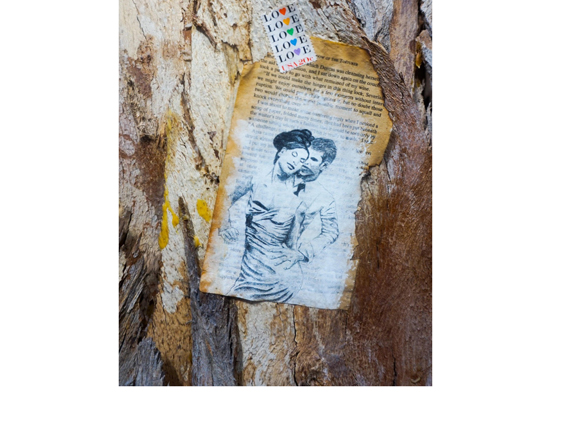Empty cereal boxes, broken wine glasses, disused ticket stubs, moldy popcorn, the rotting trunk of a tree. To most people these items are just junk, useless detritus that belong in a landfill. But to collage artist Len Davis, one man’s junk is another man’s treasure.
Davis has built a career on turning trash into art and a selection of his work is currently being showcased at Grossmont College’s Hyde Art Gallery from Jan. 29 to Feb. 23.
Empty cereal boxes, broken wine glasses, disused ticket stubs, moldy popcorn, the rotting trunk of a tree. To most people these items are just junk, useless detritus that belong in a landfill. But to collage artist Len Davis, one man’s junk is another man’s treasure.
Davis has built a career on turning trash into art and a selection of his work is currently being showcased at Grossmont College’s Hyde Art Gallery from Jan. 29 to Feb. 23.
The title of the exhibit, “A Network of Familiarity” is an apt description of Davis’ work, which turns mundane everyday items into unsettling commentaries on American society.
“Female Father Figure”, a heartbreaking and inflammatory critique of absentee fathers, is the strongest piece on display. On one side of the canvas is a pale man in overalls, holding a baby swaddled in a blanket in his arms. Behind him is a chaotic jumble of angry words crudely scrawled over a faded brick wall. “Stranded,” “Hit and run,” “Irresponsible,” “Single mother,” “Where’s daddy,” read the words.
The sickly colors and distressing words give off a sense of uneasiness and disgust and the viewer can’t help but feel sympathetic to these women’s plight.
Davis often uses unconventional canvases to frame his work and in the piece, “We Were Here,” he eschews one altogether and instead uses the rotting bark of a tree as a showcase for his art. Stapled around the large swath of tree trunk are several small drawings inked on pages ripped out of the science fiction novel “The Shadow of the Torturer” by Gene Wolfe. Each drawing focuses on a snapshot of different aspects of love. On one there is a lone woman standing naked, her arms covering her breasts and her hands clasped together in a praying motion. Her eyes are closed and she seems to be lost in thought, an expression of serene calmness on her face.
In another there is a couple frozen in the throes of dance, their bodies entwined, lost in the imaginary music. The man stares at the woman with lust, while she rests her body on his. And in yet another there is a couple intensely embracing each other, a look of immense passion on their faces. There is an undeniable sense of erotic tension present in the drawings in this piece and that, coupled with its unique presentation, makes it stand out from the others.
As is evident in the past pieces, Davis’ artwork is all about the details, and a simple cursory glance isn’t enough to soak it all in. In order to truly appreciate Davis’ work one has to spend a couple of minutes analyzing every nook and cranny on the canvas. A perfect example of this is a piece entitled “The Ex-Factor” which is a massive mosaic composed of several interconnected boxes. The piece functions like a mini cabinet of curiosities, with several found objects packed into each box including light bulbs, toothbrushes, candles, a can of Coors Light, flowers, an antique pocket watch, and a bride and groom figurine, among other things. All of the objects surround a painting of a giant crude blue face in the middle of the work with a story of love won and lost written over it. The piece is extraordinary and proves that just about anything can be used in the service of art.
While Davis’ main focus is on collage art, some of his work is done in a more traditional manner.
“The Karma Island #2,” a large drawing made with graphite on paper, is a disturbing fever dream that features nightmarish characters floating over a small decaying cityscape.
There is a man whose intestines have violently exploded from his stomach, his mouth frozen in a cry of pain. Next to him is a woman in a long flowing dress who is screaming at the top of her lungs while another woman beside is near death, her pearl necklace around her throat has been broken, sending tiny eggshell beads flying everywhere. They all seem to be lost, floating in a sea of pain and regret. It is quite an affecting piece that showcases the range of Davis’ artistic abilities.
Yet no matter what style he uses, Davis’ work is phenomenal. Sometimes playful and fun, sometimes bitingly satirical and disturbing, Davis has taken the ethos of the pop art movement and turned it on its head. An upcoming artist lecture on February 20 and an artist studio workshop on Feb. 21 will give one the opportunity to pick the brain of this unique and talented artist. There will also be a closing reception for the exhibit on Feb. 20.














